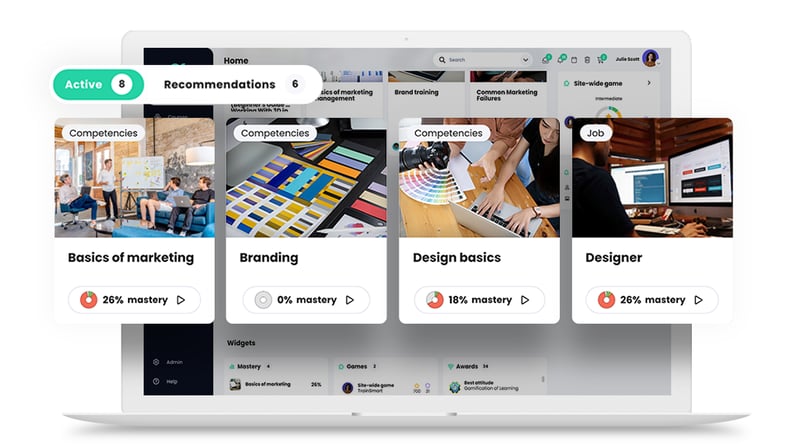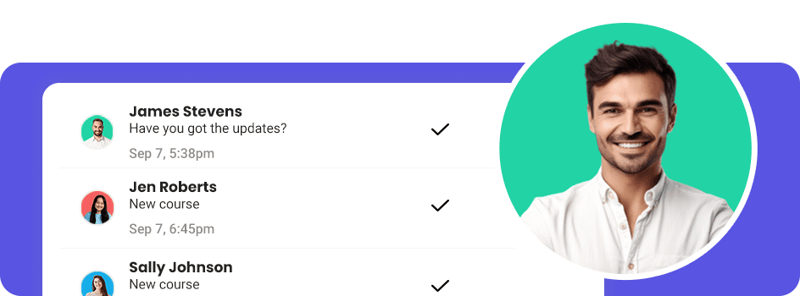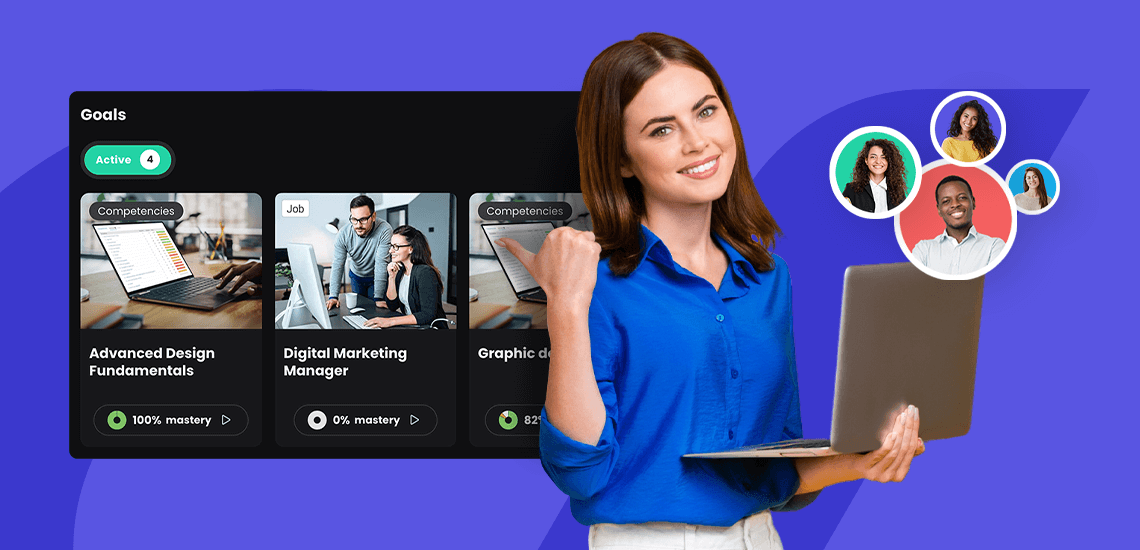Investing in employee training is a strategic move that drives growth, creative thinking, and innovation. The real value of employee training, however, comes not just from the content itself but from how well that learning gets transferred and applied in the workplace.
Transfer of learning is one of the primary measures of the success for any training program or strategy. It’s the ability to apply learned knowledge or skills to tasks at work.
Unfortunately, learning without effective transfer often ends up being just a line item in the budget—a big investment that yields little results. To ensure that your learning and development (L&D) programs are making a tangible impact on performance, it's essential to understand the many factors that can drive and support better knowledge transfer.
In this post, we’ll explore seven influencing factors that may affect the success of learning in your organization. Next, we’ll explain how to optimize your learning and development strategies to ensure that your employees retain the skills that help them excel.
7 Factors that boost the transfer of learning
Transfer of learning is crucial for businesses of any size, particularly if those organizations hope to compete in a rapidly changing market. Companies that rise to the top are those that adapt quickly, train their people thoroughly, and ensure market-ready skills for employees.
Accepting a less-than-stellar learning transfer rate is incompatible with industry best practices for corporate training and education. Even so, there’s only an estimated 20% transfer rate in the corporate training realm today, showcasing a drastic opportunity for improvement.
Luckily, there are many ways to reverse troubling trends and give your employees the tools, skills, and knowledge they need for success. Transform your organization’s training programs for the better by capitalizing on the steps and factors below.
1. Incorporate modern learning technology
Technology is often the missing link for L&D programs. A powerful learning platform can easily offer ongoing support and reinforcement of the training content, which we know is crucial to long-term retention and skills application.
Unfortunately, the days of hoping for solid learning transfer with a slide deck or well-designed PowerPoint presentation are in the past. Learners need more—in terms of engagement, personalized content, and responsive support from leaders and managers. As you consider how to improve your process to encourage greater knowledge transfer, consider how to incorporate:
- Personalized learning or skills pathways
- Digital badges, certificates, and recognitions to earn along the way
- Real-time reporting and analytics of learner performance
- Diversity and inclusion initiatives to better serve and reach all learners

How to respond and take action
Choose a user-friendly learning management system (LMS) that provides on-demand access to training materials and resources that are relevant to real-world scenarios. Incorporate gamification elements and skills levels to keep learners engaged and motivated.
Read more here: Overcoming the most common roadblocks to knowledge transfer
2. Align with top stakeholders
In order to design or launch any L&D program successfully, you first have to know and understand the expectations of all stakeholders. Instead of simply meeting Human Resources (HR) or training department objectives, seek actionable input from the individuals who will ultimately benefit from this training the most—employees and their direct managers.
Commitment and alignment are essential in any training program to prevent misunderstandings over the exact methodology, content, or processes. This is why effective communication across parties is always a key objective of the L&D department in charge of a new training strategy. When people feel included and heard in the decision-making process, they tend to learn better and commit on a personal level to the results.
Plus, corporate training that fosters individual career growth is more likely to equate to higher engagement and more active participation.
CYPHER Tip: CYPHER’s emphasis on extended enterprise training builds trust between leaders and employees by helping companies invest in long-term skills growth.
How to respond and take action
Before you flip the script on a new L&D strategy, set aside time for important focus groups, surveys, or interviews with future participants. These steps will help leaders understand the needs of those groups and highlight what they want to achieve through the training. Be prepared to explain the relevance or success potential of any new skills development program.
3. Know your learning context
Context is also a crucial factor in designing new company training programs. Learning objectives should be in line with specific business situations. For instance, if a company is introducing a new sales platform, they should create relevant training that outlines the goals and benefits of the platform and how employees can leverage it for success.
When learning is taught in a vacuum, it is rarely applied effectively. As an example, leadership training should draw on real-life leadership scenarios. When the training connects with a person’s actual job context or scenario, it becomes infinitely more useful. Retaining that information isn’t only helpful for passing a learning objective, but it could make or break or real-life business interaction. The World Economic Forum’s (WEF) latest findings also show that nearly 1 billion people will need training by 2030 to keep up with tech changes in their roles.
Remember—employees may learn more information if they see how they could benefit immediately from the acquired knowledge.
How to respond and take action
Spend time thinking about how contextual relevance can improve the transfer of learning in your specific job role or context. Explore job shadowing opportunities, case studies, and on-the-job assignments to bring training to life and demonstrate clear connections.
Read more: L&D best practices that ensure e-learning success
4. Embrace the social learning environment
When peers and managers actively encourage and support the development of new skills within an organization, a healthy culture of learning develops. And when learning goals are on everyone’s mind collectively, there’s a better chance that the transfer process is seamless.
Education (formal, casual, or community-based) tends to offer a social experience. People learn better within a mutually supportive environment. Meaningful social relationships and active collaboration with colleagues gives more people a voice in the learning process.
CYPHER Tip: Human connection is a crucial part of how and why CYPHER is different from most LMS platforms. Start using interactive chat rooms, wikis, web conferencing, web announcements, and more to ramp up social engagement in your curriculum.
How to respond and take action
It is easier for employees to take risks when they feel supported by their supervisors and colleagues. Encourage your learners to take risks and begin to apply what they’re learning. Motivate managers to participate in new L&D initiatives alongside teams. Peer learning groups and mentorship can provide additional layers of support for new skills.
Read more: 5 Tips on sustaining collaboration in remote teams
5. Leverage your learners’ motivation
Motivation leads to learning transfer. But it’s challenging to find motivation for individuals and teams, as they’re likely to vary widely based on personality, background, and learning style. In addition, because motivation levels and social environments often work in tandem, collaborative environments across teams often yield the best results.
If learners don't see the value of the training or if there's no clear incentive in the “after” scenario, transferring and retaining become infinitely more difficult. Naming both intrinsic (why learning matters personally) and extrinsic (what learning can do for a career path) motivators can also help minimize friction or pushback.
Because 59% of today’s employees believe that training improves job performance, it’s important for leadership to capitalize on this. When there’s great motivation to learn, there’s a better chance at achieving impressive results long-term.
How to respond and take action
Always communicate the reasons for any L&D training program and its potential benefits. Help learners visualize the results that they stand to gain in both the short and long term. Gamifying the experience can also be a great way to recognize and reward employees who demonstrate that they have aced and applied new skills.
Read more: Understanding employee motivation with the Self-Determination Theory
6. Integrate training within core responsibilities
Nowadays, companies are operating on less time and fewer resources. As a result, it’s important that leaders ensure that the time people spent in training is actually valuable and results-oriented. Specialized industry courses or compliance programs give employees practical skills and tools they can often put into practice the very next day.
When it comes to learning transfer, information is more likely to stick if it flows right into an employee’s everyday workload. But when new content creates confusion or disruption, it’s more difficult to retain, benefit, and move forward. Modern methods of on-the-job training also encourage things like mentorships, apprenticeships, and personalized coaching for even greater learning transfer.
CYPHER Tip: Competency-based learning can ensure that real skills mastery is taking place. That’s because competency focuses on actual demonstration of acquired skills—not simply cramming information and regurgitating it on an exam.
How to respond and take action
Start with a professional skills audit, determining where daily performance or knowledge is lacking. Show learners how new competencies can build upon what they already know. As an extension of daily routines, this type of learning shortens the path to application.
Read more: 5 Things to consider when moving towards adaptive L&D
7. Use frequent sessions to amplify results
Frequent and diverse delivery leads to better knowledge transfer than stand-alone, one-time events. That’s why opportunities like blended learning (synchronous and asynchronous) can be instrumental in shaping how your learners receive and process new teaching.
Additionally, intense learning sessions don’t have to be overwhelming. Instead of delivering massive amounts of information, focus on the depth and immersion experience of the entire learning process.
CYPHER Tip: Opt for a platform that blends the best of both worlds. CYPHER’s blended learning options incorporate flexible schedules and an enriched virtual model that helps learners master new concepts at home, at work, or in a class environment.
How to respond and take action
Incorporate many unique learning formats, such as simulations, discussions, project-based learning, and skills badges as a way to more engaging learning experiences. Encourage active participation and the chance to apply deeper critical thinking skills throughout each session.
Read more: The spectrum between synchronous and asynchronous training
Benefits of effective learning transfer strategies
A successful learning transfer doesn't just benefit the learner—it benefits the entire organization. Taking knowledge from a training program and actively applying it in the workplace often leads to improved job performance, increased productivity, and enhanced innovation.
- Improved productivity – In companies with employee training, each employee yields more income and higher revenue than in companies without.
- Reduced employee turnover – Retention rates are up to 34% higher in organizations that invest in regular, positive training.
- Higher employee engagement – According to Gallup polls, only one-third of US workers report being highly engaged in their work environments.
From the corporate side, a commitment to learning transfer can boost how employees feel about their future within one team or organization. In other words, by investing in employee development, a company can create more positive, empowering cultures.
Bringing it all together
Addressing the factors that influence learning transfer can significantly increase your learning and development ROI. By taking a holistic approach to your training efforts (including stakeholder buy-in down to individual technologies), you can transform your learning and development into organizational success.
By engaging learners and helping them take ownership of the knowledge and skills they need for growth (not simply handing them curriculum without application), you can start to produce measurable, positive changes in your workplace.
Get started now with our award-winning employee training platform.







